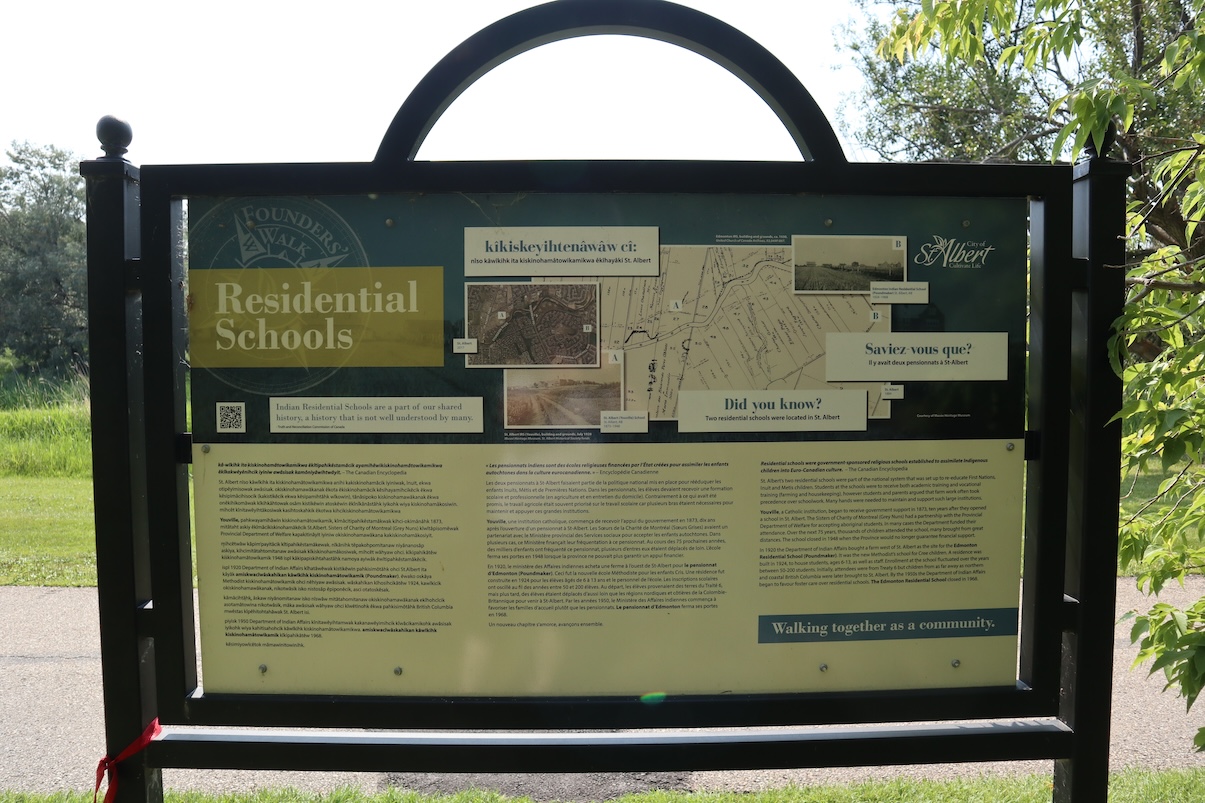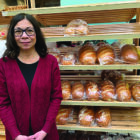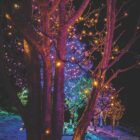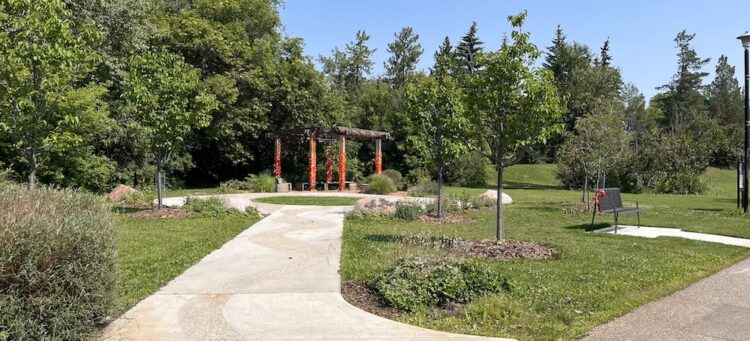
Meet You There
Kâkesimokamik – The Healing Garden
Gene Kosowan, Photography: Paula E. Kirman
March, 2024
Spiritual Healing helps to remedy the anguish of an atrocity
For the past six years, passers-by on the Red Willow Trail have had something unique to gape at besides the lush greenery melding with the Sturgeon River and St. Albert’s downtown cityscape. The attraction near Mission Park is hard to miss. A pagoda with a fan-shaped roof supported by six wooden pillars stands at the end of a wavy concrete path encircling a perfectly round patch of grass, with four giant boulders flanking the entire installation. It’s a garden, but one designed to cultivate items that are more spiritual than agrarian.
First Nations and Metis folks in the region refer to the creation by its Cree name, Kâkesimokamik, while others simply call it the healing garden. Regardless of the moniker, the structure recognizes the damage caused by the Residential School system set up nearly two centuries ago by the British and Canadian governments, designed to assimilate indigenous students into the mainstream, stripping them of their culture in the process. It also offers a safe place for survivors to deal with the atrocities they suffered.
Kâkesimokamik didn’t come into being until after the final hearing of the Truth and Reconciliation Commission, a federal initiative to investigate the shocking history of the Residential School system, had adjourned in 2015. In St. Albert, a collective of individuals including municipal delegates, residential school survivors, members of indigenous committees and the local churches convened on how to educate the public, recognize the survivors, and provide a remedy for those who continue to suffer from tenure in those schools.
Roughly a fifth of the estimated 150,000 children herded into the system across Canada died while at the schools, the last of which was shut down in 1996. St. Albert had two such schools in the region. One was located on nearby Mission Hill, while the other was situated roughly six km. further east of downtown in what is now Poundmaker Lodge.
Former United Church minister James Ravenscroft came up with the idea of a healing garden, which ticked all the boxes concerning what the committee was looking for. The aptly-named St. Albert Healing Garden Committee then approached internationally-recognized architect Douglas Cardinal − an Albertan with Blackfoot and Cree lineage and whose curvilinear approach to design resulted in works that include St. Albert Place and the Canadian Museum of History − to design the structure.
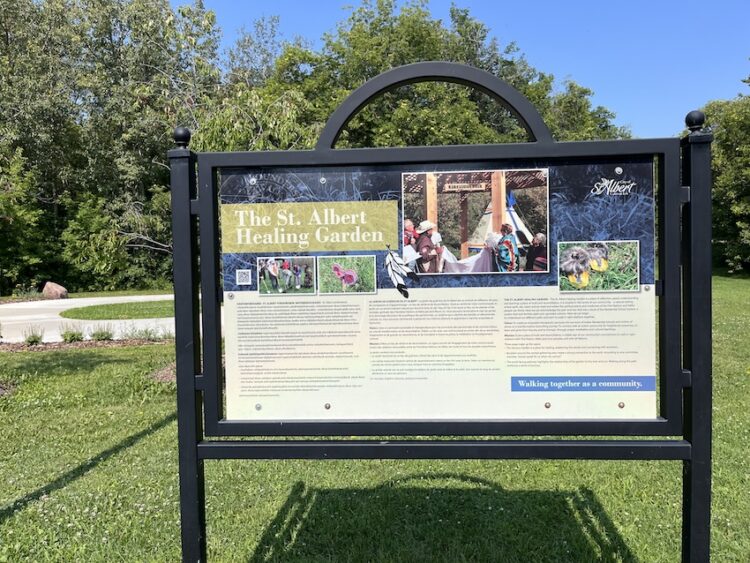
The City green-lit the project the same year, with funding from all three levels of government and private donors that included the local Anglican and United churches, the St. Albert Rotary Club and Muriel Martin Elementary School. A spiritual pipe and sod-turning ceremony launched Kâkesimokamik’s construction in May, 2017 until its completion four months later.
“There have been challenges with the process, funding and support,” said the City of St. Albert in a statement before Kâkesimokamik’s unveiling. “However, in taking small steps toward reconciliation, there has been learning, understanding, and signs of hope, demonstrating that we are indeed on the right path.”
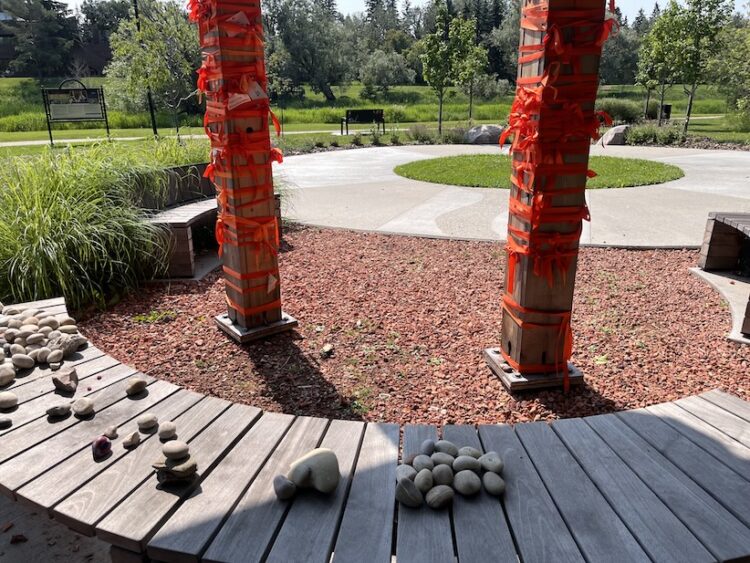
Addressing the needs of Residential School survivors may have been a major motivator for making the installation happen, but those involved in its creation have been quick to point out that anyone coming across Kâkesimokamik is welcome to access it.
“We invite all families, any family, any background, anything to come to our garden and come and join our circle,” said Hazel McKennitt, a survivor of Manitoba’s Residential School system, at the opening ceremony. “So from here on we will walk together, we will walk beside each other, and we will help on this journey to our truth and reconciliation.”
Accessing Kâkesimokamik from the Red Willow Trail is a symbolic journey in itself. The winding pathway emphasizes the garden’s affiliation with the Sturgeon River and the sun, with the boulders symbolizing their strong link to the earth. The garden and pagoda offers a chance for users to experience a sensory awakening, a healing process, and a realization of their ancestral bonds. In 2022, Kåkesimokamik experienced an auspicious addition, when electric power supplier FortisAlberta donated a bench to the site.
It seems like kismet that Kåkesimokamik − one of the first structures of its kind created in the country − directly faces the Cardinal-designed St. Albert Place, on the south side of the river. Still it’s hard to argue that the surroundings offer a tranquil atmosphere to cast an idyllic air of sorts to visitors, while those who find deeper meanings in Kâkesimokamik likely find peace of mind at the site.
But for those responsible for the installation, Kâkesimokamik is only just the beginning. “As a municipality, we are still finding our way in terms of how we will respond to the Calls to Action identified in the Truth and Reconciliation Report,” said the City of St. Albert in a statement. “However we have taken our first steps together.”
